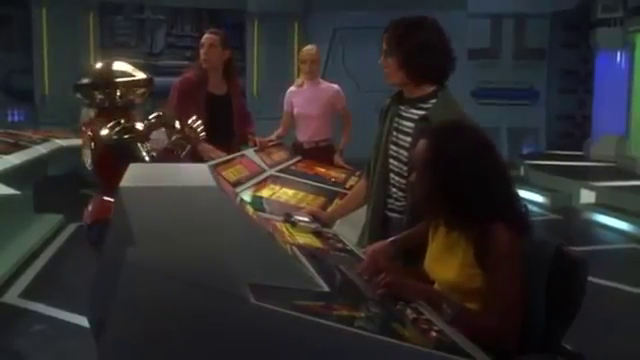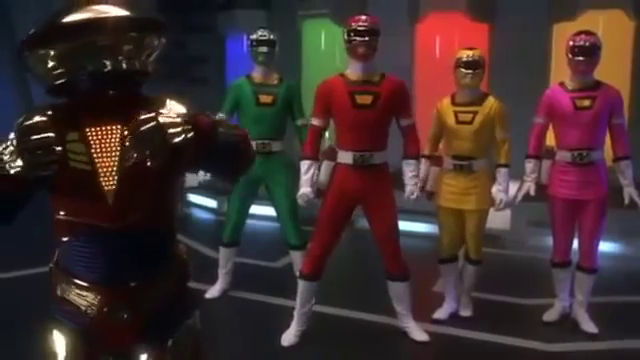
#346 – Turbo: A Power Rangers Movie (1997)
Turbo: A Power Rangers Movie (1997)
Film review #346
Directors: David Winning, Shuki Levy
SYNOPSIS: The evil space pirate Divatox is planning to capture the wizard Lerigot in order to use his golden key to release and marry Maligore, whose powers she believes will make her unstoppable. Lerigot escapes to earth to enlist the help of Zordon, but ends up in Africa. Zordon sends Tommy and Kat to find Lerigot before Divatox, but she has kidnapped Lerigot’s family, and he surrenders to her. Zordon gives the power rangers new powers in order to follow Divatox through the nemesis triangle to the island where Maligore is sealed, and to stop her before it is too late…
THOUGHTS/ANALYSIS: Turbo: A Power Rangers Movie is a 1997 film that is a sequel to the 1995 film and a precursor to the Power Rangers Turbo TV series. The film opens with scrolling text that is very reminiscent of Star Wars, which describes how the wizard Lerigot possesses a golden key which is able to unseal the monster Maligore, whose evil powers would ravage the galaxy. The space pirate Divatox plans to release Maligore and marry him so their combined powers would let her plunder the galaxy. Meanwhile in Angel Grove, the male power rangers are entering a kickboxing tournament in order to win the prize money to save a local youth shelter from closing. One of the children who uses the shelter, Justin, comes to see them training just as Rocky, one of the power rangers, has an accident and hurts his back. The rest of the team go to visit him in the hospital, when Zordon calls them back to find Lerigot, who has arrived on Earth. Justin also overhears their conversation and finds out that they are the power rangers. Two of the rangers, Tommy and Kat, are teleported to Africa to find Lerigot before he is weakened too much by the sun’s rays, which are harmful to him. The plot of the film feels more like a fantasy than a sci-fi, with all this talk of wizards, magic, and fantasy-sounding names and locations. One of the problems I highlighted in my review of the previous film is that it didn’t really expand on the Power Rangers experience or offer anything more than a longer episode of the TV series, and thus struggled with filling the film with content. Turbo seems to have gone the other way: it fills the film with all these different concepts, settings and characters so that there is a new experience for the viewer, but it does so much of it that it stops feeling like a Power Rangers film, and the things you want to see are relegated to short and scattered scenes. In fact, we don’t even see the power rangers in their suits until nearly half way through, making the opening really feel like a slow crawl before anything of significance or what you would come to see starts happening on screen.
The Power Rangers themselves are the same ones from the TV series at that point in time, and aren’t particularly developed as individual characters. two of the original rangers, Jason and Kimberley, also make an appearance, as well as the ever-present Bulk and Skull, and so if you’ve followed the series at any point, you’ll recognise these characters fairly easily. The performances, while not amazing, aren’t too bad, and convey a decent amount of emotion and expression; and you don’t need too much more in a film aimed at children. Divatox and her minions are also full of energy, and give off that evil vibe quite well, alongside a little incompetence that makes them not too threatening or scary. There’s also a cool little cameo featuring original villains Rita Repulsa and Lord Zedd, which will no doubt make fans smile.
One of the big issues of this film is that the kid Justin ends up being the blue ranger, and accompanying the rest of the group to stop Divatox. I can’t fault the kids acting, but everything about the character makes no sense and ruins the image of the Power Rangers: the description of them being “teenagers with attitude” just doesn’t work when one of them is a kid, and when the Power Rangers do something cool, he still just acts like a kid, which takes some energy out of the scenes. No explanation is given of why he suddenly becomes the blue ranger; he literally just shows up and says “I’m the blue ranger now”. I think it’s implied that because he worked out that Tommy and the rest were Power Rangers, then he would have to join them, but it’s also established that Power Rangers are chosen because of their heroic qualities or attitudes, and it’s not really mentioned or established which of these qualities Justin has. I get that his character is meant to be one that kids can relate to, and gives them the impression that they could be a Power Ranger too, especially given that he is a troubled kid who is sad and outcast and has issues with his Dad, and can still be a Power Ranger (his background isn’t explored in any huge detail), but this is one of these storytelling devices that I would have hated as a kid, as it broke with what made the Power Rangers who they were: that they were special, and their heroic qualities meant they could do great things, and become Power Rangers. If any kid could do it, then that inspiring sense of justice and heroism just gets diluted and makes it less special. That’s how I would have seen it as a kid anyway. There’s also the issue of Justin growing about two foot taller when he morphs into the blue ranger, which is never acknowledged, referenced or explained, and just breaks a sense of immersion because it raises so many questions. The Power Rangers series uses footage from the Super Sentai TV series in Japan for the segments in costume and the robot zords, with the American actors providing the voiceover, and since in the original show the blue ranger wasn’t a little kid, the Power Rangers series just avoids referencing it.
The Power Rangers travel on board a “Ghost Galleon”, which looks like an old wooden sailing ship, in order to pass through the inter-dimensional “nemesis triangle” to the island where Maligore is imprisoned. Again, there’s a decent amount of content in the story, but the fantasy tone doesn’t really fit with the Power Rangers theme, which is more science-fiction. Eventually, near the end of the film, it gets back to the traditional Power Rangers formula of martial arts action, then giant robot vs monster action, but by that point I just felt exhausted by the long-winded way in which it got there that it was difficult to care anymore. The robots or Zords that the rangers pilot this time around are different types of vehicles. One of the big criticisms of the previous film I had was that the Zords were rendered in CGI, and looked pretty bad, as well as looking a lot different than the TV series, which used models and actors in costumes. Turbo instead keeps things consistent, and uses the model and costume footage from the TV series, as well as creating new models for the Zords, which are all vehicles of some form. This consistency is very welcome, and while the cars do look like they’ve just been made by recolouring some original vehicles with matte paint and sticking a few bits on top, they still fit in with the rest of the effects. The effects on the whole are okay: nothing special, but again it keeps them consistent with the feel of the film and series, which are never high budget extravaganzas. The film ends as you would expect with the Rangers Zords combining to defeat a giant Maligore, and saving the world as always, and it does it in exactly the way you would expect, with the extended transformation sequence, the theme music pumping in the background, and seeing both of them show off their moves. It definitely feels like a Power Rangers movie at the end. Oh yeah and they also win that kickboxing tournament that was mentioned at the start of the film, just in case you were wondering even though it was not mentioned at any other point.
Overall, Turbo: A Power Rangers Movie seems to take the contrary approach than its predecessor, by creating a stronger narrative and quest that gives the Power Rangers purpose and motivation. However, this often has a detriment effect, as all of the extra characters, locations and plot devices can distract from what you want to see in a Power Rangers film. The previous film added as little as possible and suffered for it as well, and it seems Turbo just jumped to the other extreme without finding the middle-ground. However, on the whole it does keep itself in line with the franchise, and delivers everything you would expect it to, along with familiar use of effects, music and styles that make it feel like a Power Rangers movie. The characters, while still underdeveloped, turn in a decent performance; even the kid Justin does a good job, in spite of finding his character unpalatable and an overall distraction. Some throwbacks to older characters and the typical fight scenes make it a good watch for Power Rangers fans, and even though it doesn’t offer anything new or exciting, underneath all the superfluous fantasy stuff there seems to be a good understanding of what makes Power Rangers work, and how to pull it off. There won’t be much substance in here for non-Power Rangers fans, and it’s not amazing for a standalone film, but for the fans there’s plenty of what fans would want.
Oh, and I now have the “Power Rangers Turbo” theme stuck in my head. Forever probably.










